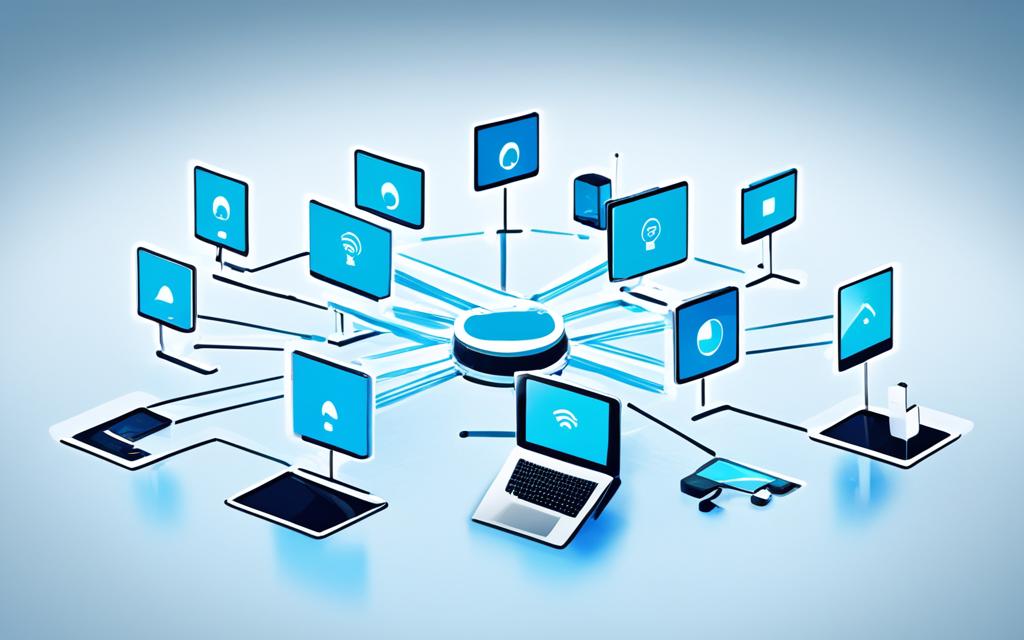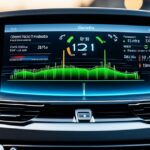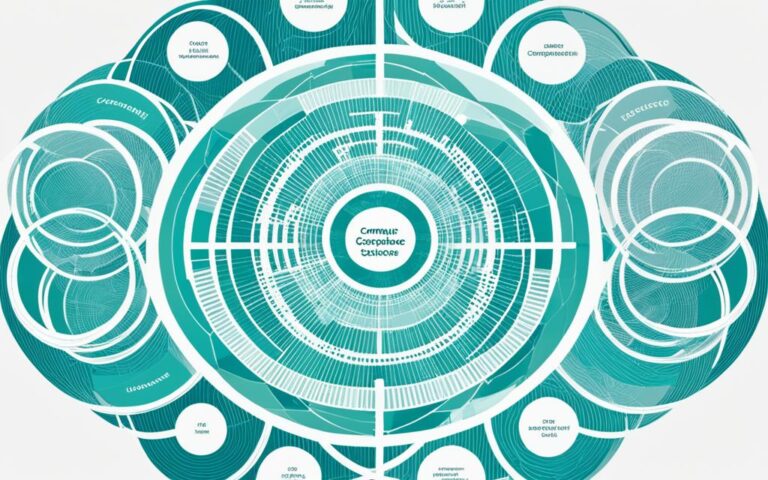The Internet of Things (IoT) has changed the tech world, making many industries more efficient and cost-effective. At the core, embedded systems link physical devices with the digital world. They combine computer parts to do specific tasks.
These systems can work alone or with others, making them key to IoT. They use sensors to collect data in real-time, helping with quick decisions. The industrial sector is a big user of IoT systems for its complex operations and need for remote checks1.
Industrial IoT (IIoT) uses these systems with sensors to watch over equipment and track assets. This helps manage operations better, cuts downtime, and boosts productivity. In healthcare, wearable devices with IoT tech track patient health and monitor vital signs from afar1.
Cars also use IoT systems for things like checking tire conditions and air pressure1. This keeps drivers safe and helps with maintenance, making cars last longer and saving money.
Retail shops use IoT for tracking stock, improving supply chains, and making shopping better for customers1. They gather data to make operations smoother, improve shopping, and make smart choices.
Smart home devices like thermostats and security cameras are another big use of IoT tech1. They make homes more comfortable and secure, letting people control things from anywhere and feel safe.
Key Takeaways:
- The IoT has changed industries with embedded systems, linking hardware and software for specific tasks.
- These systems are vital for IoT, offering real-time monitoring and data for better decisions.
- IoT systems are used in many areas, like industry, healthcare, cars, shops, and homes, making things safer and more efficient.
Stay tuned for the next part of this article. We’ll look more at how embedded systems work in IoT and their uses across different industries.
The Role of Embedded Systems in IoT
Embedded systems are key to the IoT world. They mix computer hardware and software to do specific tasks well and efficiently2. These systems are used in many areas like smart homes, industrial automation, healthcare, agriculture, and transport. They make IoT devices work better by letting them share and process data securely and efficiently2.
Embedded systems in IoT face challenges like saving energy and keeping data safe2. They must work well with different devices from various brands2. As more devices connect, handling the data and devices becomes a big task2. They also need to work fast for real-time monitoring and control2.
Embedded systems have changed many industries by making them more automated and advanced. In smart homes, they control lights, temperature, security, and entertainment, making life easier and saving energy2. In industrial settings, they help monitor production, find problems, and improve efficiency2. In healthcare, they track vital signs, help with medication, and send data to doctors quickly2. In farming, they help use resources wisely, monitor the environment, and increase crop yields while saving water2. In transport, they track vehicle performance, plan routes, improve logistics, and cut fuel use2.
The demand for embedded systems is growing fast because they’re used in phones, cars, appliances, and IoT devices3. They are cost-effective, reliable, energy-efficient, secure, and easy to update, making them great for IoT3. The market for embedded systems was over $140 billion in 2022 and is expected to grow by more than 6.5% a year from 2023 to 20324. This growth is because more people want IoT devices for their convenience and benefits4.
In summary, embedded systems are crucial for IoT, making devices connect, monitor, automate, and analyze data. They combine hardware and software to make IoT devices efficient and reliable. As IoT grows, embedded systems will keep driving innovation and improving our lives.
Examples of IoT Embedded Systems
IoT embedded systems have changed many industries, offering lots of benefits. Let’s look at some examples of how they’ve changed different sectors.
Industrial IoT Devices
According to statistics from the Digi International, industrial IoT devices have made it possible to monitor and improve operations from afar. This has made things more efficient and safer5.
In manufacturing, IoT systems help keep an eye on and manage processes as they happen. They gather data from sensors and machines, giving insights to make production better and avoid downtime. These devices help with predictive maintenance, cutting costs and keeping things running smoothly. They also make workers safer by watching over the environment and warning of dangers.
Wearable Devices
According to Emteria, wearable devices with IoT tech let doctors check on patients remotely and give health tips tailored to each person6.
Wearable tech, like fitness trackers and health monitors, has changed how we keep track of our health. These systems collect data on things like heart rate, activity, and sleep. This helps people stay on top of their health and make better choices. Doctors can also keep an eye on patients from afar, spotting problems early and acting fast.
Smart Vehicles
According to LinkedIn, IoT in cars gives updates on routes, checks tire health, and helps with driving safety7.
Smart cars use IoT to make driving safer and better. They give updates on routes, so drivers get where they need to go fast. They also keep an eye on tire pressure and health, warning drivers of any issues. And with IoT tech, cars can help with things like staying in lanes, controlling speed, and avoiding crashes.
Intelligent Retail
The use of IoT in shops helps manage stock better, gives shoppers personalized experiences, and makes checking out faster, as Emteria shows6.
In shops, IoT has changed how we shop. Stores use IoT to keep track of stock in real-time, making sure they have what customers want. These systems also make shopping personal by using customer info for tailored advice and deals. And with self-checkout, shopping is quicker and less of a wait for everyone.
Smart Home Devices
According to the Digi International, smart home gadgets like thermostats and cameras make life easier, cozier, and safer for homeowners5.
IoT has made smart homes a reality, letting us control our homes from anywhere. Smart thermostats let us set temperatures and save energy smartly. Cameras with IoT tech keep an eye on our homes, giving us peace of mind. And with IoT, we can control lights, appliances, and more from afar, making life more convenient.
These examples show how IoT embedded systems are changing many areas of life. They make things run better, keep us safer, improve health care, make shopping better, and turn homes into smart spaces. As technology gets better, IoT will likely have an even bigger impact on our lives.
The Components of an IoT System
An IoT system has several key parts that work together. They create a network that connects everything smoothly.
Sensors and actuators are crucial. They collect data and act on it. Sensors check things like temperature and light. Actuators control devices or start processes.
Connectivity modules are key for data sharing between devices. They use Wi-Fi, Bluetooth, or cellular networks. This ensures devices talk to each other well.
Data from sensors gets processed. This means making sense of the data. Often, machine learning is used to get insights and make smart choices.
User interfaces make IoT systems easy to use. They let users check the system, control devices, and interact with it from anywhere.
IoT systems work together well. Designers must think about power, size, and use cases. This helps pick and design the right systems8.
By 2025, over 30 billion IoT connections are expected. That’s about four devices for every person9. McKinsey predicts a big jump in 5G IoT module revenue to almost $10 billion by 20309. IoT has changed business, improved customer experiences, and made operations smoother9.
The key parts of an IoT system include sensors, actuators, connectivity modules, data processing, and user interfaces. Together, they make a powerful network. This network can change many industries and make life better. Knowing these parts is key for making great IoT solutions8.
Types of Embedded Systems
Embedded systems can be sorted by their performance and what they do. It’s key to know the different types for making IoT apps work well. Each type has its own role in fields like healthcare and cars.
Real-time Embedded Systems
Real-time embedded systems are vital in fields needing quick data handling and action. They’re found in manufacturing and healthcare, where speed matters. These systems can be “soft” or “hard” real-time, based on how strict the timing needs are. Soft systems can delay a bit, but hard systems must meet deadlines.
Standalone Embedded Systems
Standalone embedded systems work on their own without needing extra tech. They’re self-sufficient and handle specific tasks. Examples include cameras, watches, and MP3 players.
Network Embedded Systems
Network embedded systems connect to networks to share data and produce outputs. They’re key in security, sales, and ATMs. These systems make sure devices talk to each other smoothly within a network.
“The Internet of Things is not about computers, devices, and networks; it is all about people and creating meaningful experiences.” – Jacques de Villiers
Mobile Embedded Systems
Mobile embedded systems are small and found in devices like phones. They make smartphones work, offering both mobility and ease. These systems include many parts like software, cameras, and microphones.
Visualizing the Types of Embedded Systems
Let’s look at a visual guide to understand embedded systems better:
| Embedded System Type | Description |
|---|---|
| Real-time Embedded Systems | Used in time-sensitive industries like manufacturing and healthcare, with specific timing requirements for data processing and response. |
| Standalone Embedded Systems | Operate independently without relying on a host; self-contained systems with specific functions. |
| Network Embedded Systems | Connected devices that rely on networks to exchange data and generate output. |
| Mobile Embedded Systems | Portable systems used in mobile devices, leveraging various components for enhanced functionality. |
(Table representing the types of embedded systems)
Knowing about embedded systems helps in making IoT solutions for different industries. Whether it’s for precise control, standalone tasks, networked systems, or mobile use, each type is crucial in the IoT world.
As technology gets better, the demand for embedded systems grows. They drive innovation in many areas, from cars to healthcare and homes. By using embedded systems, we can make the world more connected and efficient.
“The challenge is not just developing the latest technology stack but understanding and enhancing the human condition.” – Vineet Nayar
References:
- MarketsandMarkets. “Embedded Systems Market by Hardware, Software, System, Application, and Geography – Global Forecast to 2025.” MarketsandMarkets10.
- Link 2
- Link 3
Real-Life Example of an IoT Embedded System
IoT embedded systems have changed many industries, bringing big improvements and clear benefits. Let’s look at some examples of how they’re making a difference in various sectors.
Industrial IoT
In the industrial world, IoT systems make things run better and safer. They use sensors and devices for checking on things from afar. This helps make processes smoother and cuts down on wasted time11.
Almost all modern machines in industries use these systems, with 98% of automation systems having them11. IoT systems help predict when machines might break down, cutting downtime by 30%11. This means machines work better and saves money from unexpected stops.
Wearable Devices in Healthcare
The healthcare field has taken to IoT systems to improve care and keep an eye on patients from afar. Wearable tech, or the Internet of Medical Things, is changing how we support health. These devices track health data continuously, offering tailored care.
Wearable devices in healthcare are great for keeping an eye on patients from anywhere. They track things like blood pressure and oxygen levels, giving doctors real-time updates12. This helps spot health problems early, cuts down on hospital visits, and betters patient care.
Smart Vehicles for Road Safety
IoT systems are key in cars, making roads safer and cars run better. They help with navigation, checking tire health, and avoiding crashes.
Systems like Collision Avoidance have cut road accidents by 25%, saving thousands of lives each year11. These systems use sensors to spot potential crashes and warn drivers, lowering accident risks. IoT systems also cut costs by 15% in the car industry by making things more efficient11.
Smart Homes and IoT Integration
IoT systems in smart homes make life easier, safer, and more comfy. Devices talk to each other, making things run smoothly.
Automated security systems are a great example of IoT in smart homes. They use tech for cameras, sensors, and locks, letting people check on their homes from anywhere. This boosts security and peace of mind.
Retail Solutions for Enhanced Customer Experience
Retailers use IoT systems to offer personalized deals, manage stock better, and improve shopping. These systems collect data, automate tasks, and connect with customers.
For example, IoT helps with self-checkout in stores. It links inventory, sales systems, and loyalty programs, making shopping smoother. This keeps retailers ahead in the digital age.
Challenges of Embedded Systems Development
Creating embedded systems for IoT comes with unique challenges. These need careful thought and creative solutions. From making sure they work well and last long to dealing with hardware limits and keeping data safe, the process is tough. Let’s look at the main challenges in making embedded systems.
Stability: The Foundation of Reliable IoT Systems
Stability is key in making embedded systems. IoT devices must work well for a long time without losing data or crashing. To do this, developers must make the software better, especially with limited power and memory13. By doing this, they make the systems stable and quick, ensuring they work smoothly.
Hardware Limitations: Overcoming Constraints
Embedded systems have limited memory and power. This can affect how well and fast IoT devices work. To beat these limits, developers must use resources wisely and write efficient code13. This way, the systems can work well even with limited hardware, giving the best performance.
Security Concerns: Safeguarding Sensitive Data
Security is a big deal in making IoT embedded systems. These devices connect to networks and send out important data, making them targets for hackers. To keep data safe, strong security steps are needed, like encrypting data and using secure login methods13. These steps help protect against security risks, keeping user data safe and private.
Testing: Ensuring Functionality and Security
Testing is crucial in making sure IoT devices work right and are secure. Different tests are used to check the software’s performance and safety13. Through detailed testing, developers can find and fix problems, making sure the systems work as they should and stay safe from threats.
Scalability: Accommodating Growth and Complexity
As IoT grows, making systems that can handle more devices is a big challenge. Developers must think about memory, power, and handling lots of devices13. By designing systems that can grow, developers can keep IoT devices running smoothly as more devices connect.
Maintenance: Enabling Remote Updates and Repairs
Maintenance is tough in IoT embedded systems. Devices are often in hard-to-reach places, making updates and fixes hard. To solve this, developers should make it possible to update and fix devices remotely13. This makes managing IoT devices easier and keeps them working well, even in far-off places.
Conclusion
IoT embedded systems have changed many industries, making them more efficient and cost-effective. They help in areas like healthcare, transportation, retail, and even in our homes. These systems have led to new solutions in many sectors.
Adding IoT to devices brings challenges, like stability and security issues14. But, the benefits are much bigger. With more devices joining the IoT, we can expect better designs and more innovation14. The North American embedded industry is also showing great promise for IoT innovation14.
Embedded systems are key to IoT’s success. They offer reliability and real-time control, making them ideal for IoT devices15. They use resources wisely and focus on specific tasks. This makes them a top choice for IoT developers15.
These systems also help make IoT devices more energy-efficient16. They ensure data stays safe, which is a big concern for IoT projects16.
The IoT market is booming, expected to hit $1.6 trillion by 202516. Already, 67% of businesses use IoT devices16. Embedded systems in IoT have a 99.9% reliability rate, showing their strength and dependability16.
They are designed to grow and adapt, making IoT devices perform better16. This flexibility and focus on performance make them essential for IoT success.
FAQ
What is the role of embedded systems in IoT?
Embedded systems are key in the IoT world. They use computer hardware and software to do specific tasks. They’re not just for IoT but are a big part of it. IoT is about connected devices sharing data online. Embedded systems help with this by making sure devices can talk to each other and the internet.
This mix of embedded systems and IoT lets us monitor things from afar, control equipment, and make sense of data. It also helps automate tasks.
What are some examples of IoT embedded systems?
IoT embedded systems are used in many areas. In industries, they help manage things from afar, make things more efficient, and keep people safe. They’re also in health devices that track patients’ health and give advice in real-time.
Smart cars use them for better navigation and to check tire conditions. In shops, they help track stock, improve supply chains, and make shopping personal. At home, they make things like thermostats and security cameras more useful.
What are the key components of an IoT system?
An IoT system has several important parts. Sensors and actuators gather and act on data. Connectivity modules, like Wi-Fi or cellular, send data between devices. Processing data is key, often using machine learning to understand it.
Interfaces let people interact with the system. All these parts work together for a smooth IoT experience.
What are the types of embedded systems?
Embedded systems vary by what they do and how they work. Real-time ones are crucial in fast-action fields like healthcare. Standalone ones work on their own without needing extra tech.
Network ones talk to other devices, while mobile ones are on the move but might have size limits. These types help us know what each embedded system can do.
What are some real-life examples of IoT embedded systems?
IoT embedded systems are used in many everyday situations. In industries, they boost efficiency and safety by monitoring things from afar. Health devices track patients’ health and offer advice on the go.
Smart cars get better navigation and tire checks. Smart homes make life easier and safer for their owners. Shops use them for personalized shopping and efficient stock management. These examples show how IoT embedded systems make a big difference in our lives.
What challenges are faced in embedded systems development?
Making embedded systems for IoT has its hurdles. They must be stable and reliable to avoid losing data or crashing. They’re limited by hardware, like memory and speed, which affects how well they work.
Security is a big worry as connected devices can be hacked. Strong security steps must be taken to keep data safe. Testing is key to make sure these systems work right before they’re used. Overcoming these challenges is crucial for making dependable IoT embedded systems.
Source Links
- https://www.velvetech.com/blog/iot-embedded-systems/ – How IoT Embedded Systems Are Impacting Industries – Velvetech
- https://technosofteng.com/the-role-of-embedded-systems-in-the-iot/ – Role of Embedded Systems in the Internet of Things
- https://www.tutorialspoint.com/the-role-of-embedded-systems-in-the-internet-of-things-iot – The Role of Embedded Systems in the Internet of Things (IoT)
- https://intechhouse.com/blog/the-role-of-embedded-systems-in-iot-applications/ – The Role of Embedded Systems in IoT Applications – INTechHouse Blog
- https://www.digi.com/blog/post/examples-of-embedded-systems – 10 Real Life Examples of Embedded Systems
- https://emteria.com/blog/iot-embedded-system – IoT embedded system: All you need to know
- https://www.linkedin.com/pulse/iot-embedded-systems-advancements-challenges-iies-iies – IoT Embedded Systems: Advancements and Challenges – IIES
- https://www.techtarget.com/iotagenda/tip/A-look-at-how-IoT-and-embedded-systems-work-together – A look at how IoT and embedded systems work together | TechTarget
- https://ubidots.com/blog/iot-embedded-systems/ – The Connection Between Embedded Devices (Systems) & IoT
- https://www.techtarget.com/iotagenda/definition/embedded-system – What is an Embedded System?
- https://www.linkedin.com/pulse/unveiling-role-embedded-systems-our-daily-lives-cpp-psp-pmp-pci-cc-go7mf – Unveiling the Role of Embedded Systems in Our Daily Lives
- https://lembergsolutions.com/blog/5-real-life-examples-embedded-systems – 5 Real-Life Examples of Embedded Systems | Lemberg Solutions
- https://www.linkedin.com/pulse/challenges-faced-developing-embedded-software-iot-devices – CHALLENGES FACED IN DEVELOPING EMBEDDED SOFTWARE FOR IOT DEVICES
- https://www.penguinsolutions.com/company/resources/newsroom/introduction-embedded-systems-iot – An Introduction to Embedded Systems and Internet of Things
- https://theiotacademy.medium.com/difference-between-embedded-systems-and-the-internet-of-things-iot-9f8bb21187ba – Difference Between Embedded Systems and the Internet of Things (IoT)
- https://dzone.com/articles/iot-and-embedded-systems-a-brief-analysis – IoT and Embedded Systems: A Brief Analysis – DZone


















